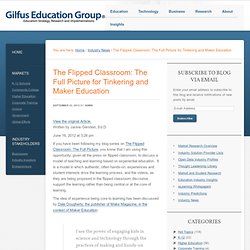

The Flipped Classroom: The Full Picture for Tinkering and Maker Education. View the original Article.

Written by Jackie Gerstein, Ed.D. June 16, 2012 at 3:26 pm If you have been following my blog series on The Flipped Classroom: The Full Picture, you know that I am using this opportunity, given all the press on flipped classroom, to discuss a model of teaching and learning based on experiential education. It is a model in which authentic, often hands-on, experiences and student interests drive the learning process, and the videos, as they are being proposed in the flipped classroom discourse, support the learning rather than being central or at the core of learning.
The idea of experience being core to learning has been discussed by Dale Dougherty, the publisher of Make Magazine, in the context of Maker Education: I see the power of engaging kids in science and technology through the practices of making and hands-on experiences, through tinkering and taking things apart. . . . exemplifies the kind of passion and personal motivation that inspires innovation.
Educational Vodcasting - Flipping the Classroom. Five Ways to Flip Your Classroom With The New York Times. Jim Wilson/The New York TimesSalman Khan in the offices of his company, Khan Academy, in Mountain View, Calif.

His math lessons are popular on YouTube.Go to related article » What is a “flipped classroom”? It’s an “inverted” teaching structure in which instructional content is delivered outside class, and engagement with the content – skill development and practice, projects and the like – is done in class, under teacher guidance and in collaboration with peers. A flipped class swaps explanation and lecture, which are usually given in the classroom, with homework activities like math problem sets or writing practice activities.
Homework becomes classwork and vice versa. Usually, teachers flipping their classrooms convey content using technology tools like videos, podcasts or PowerPoint presentations, which students explore on their own time. Sometimes teachers create lectures and other resources themselves using resources like Teacher Tube, the Show Me app or a voice recording tool. How the Flipped Classroom Is Radically Transforming Learning. Editor's Note:Posts about the flipped class on The Daily Riff beginning in January 2011 have generated over 240,000 views to-date - thanks contributors and readers . . .

See our other links related to the flipped class below this guest post. Since this post was written, Bergmann and Sams have released their book, Flip your Classroom: Reach Every Student in Every Class Every Day. Do check it out. - C.J. Westerberg How the Flipped Classroom was Born by Jonathan Bergmann and Aaron Sams In 2004, we both started teaching at Woodland Park High School in Woodland Park, Colorado. "And how the Flipped Classroom changes the way teachers talk with parents And then one day our world changed. Flipping Increases Student Interaction One of the greatest benefits of flipping is that overall interaction increases: Teacher to student and student to student. Some might ask how we developed a culture of learning. There are a myriad of reasons why a student is not learning well.
Are you Ready to Flip? Five Ways to Flip Your Classroom With The New York Times.